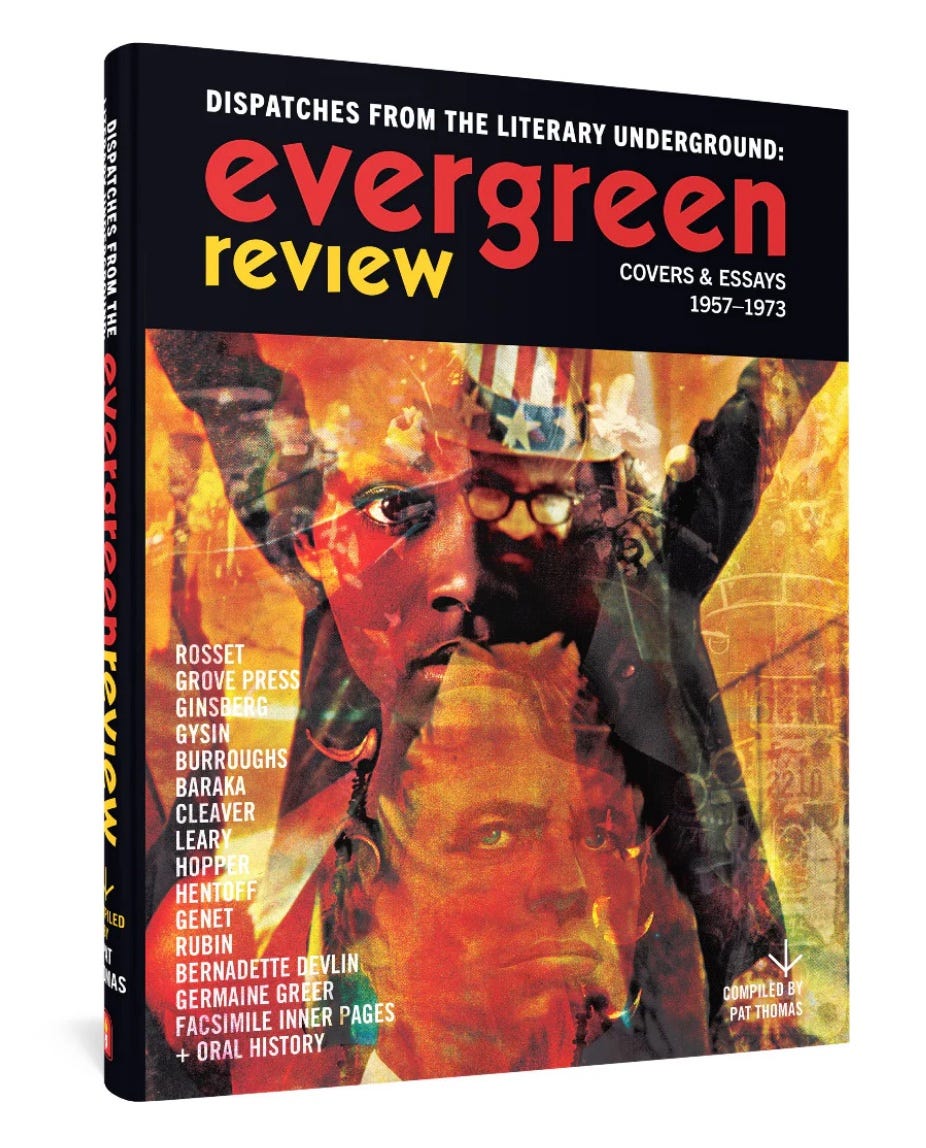Evergreen Review: Dispatches from the Literary Underground, Covers & Essays 1957-1973, compiled by Pat Thomas (Fantagraphics, 2025)
By Jonah Raskin
ALONG WITH The Realist and Mad, Evergreen Review was the essential magazine for members of the avant garde. I remember it well. It had to be read and savored to stay informed about the new, innovative writers and the various movements the quarterly spurred on. Meanwhile, glossy Playboy offered eye-popping centerfolds and long informative interviews.
Evergreen had a little bit of everything for everyone, except squares. It had pornography, satire and the surreal. It had great literature by the likes of Camus, Artaud and Grass, Brautigan and Ferlinghetti, plus interviews with a few women, too, including Irish firebrand Bernadette Devlin and the Australian iconoclast and feminist Germaine Greer, the author of The Female Eunuch, one of the most provocative books to appear in the early 1970s, the golden age of Women’s Liberation literature.
Founded in 1957 by Barney Rosset at Grove Press – which published Julius Lester’s Look Out, Whitey! Black Power’s Gon’ Get Your Mama!, Franz Fanon’s Black Skin, White Masks and many other pivotal texts for the cultural revolution – Evergreen ran until 1984 when it collapsed with a bang and a whimper. Fans mourned its all too early death.
Now, all the first 100 issues, up to 1973, are back in print with essays and essential information by compiler/editor Pat Thomas, a man who has, in the recent past, chronicled the Black Panthers, exhumed the archives of Beat poet Allen Ginsberg and traced the career of the irascible Yippie/yuppie Jerry Rubin.
‘This is the first ever facsimile reproduction of the original pages from the magazine,’ Thomas writes, ‘so you can see what else was on that page – be it a photograph or illustration, an ad for a book or record album or part of an entirely different article.’ He adds, ‘This is the closest you’re gonna get to owning a stack of rare Evergreen Review magazines.’
Though it was both hot and cool and helped to turn the world into a global village, it also struggled to survive financially. Its content was truly eclectic as Brion Gysin wrote about cut-ups, much favored by William Burroughs, Judith Malina described the trials and tribulations of the Living Theater and lawyer Edward de Grazia and novelist Norman Mailer talked about the Naked Lunch trial in Boston.
Observed Mailer: ‘William Burroughs is in my opinion – whatever his conscious intention may be – a religious writer. There is a sense in Naked Lunch of the destruction of the soul, which is more intense than any I have encountered in any other modern novel.’ He added, ‘What gives this vision a machine-gun-edge clarity is an utter lack of sentimentality.’
Evergreen eschewed sentimentality all the while situating readers in front row seats and also took them backstage to meet the makers and shakers of postmodernism. Pat Thomas includes the barbs that feminist Robin Morgan hurled at the publication. ‘No more using women's bodies to rip off enormous profits for a few wealthy capitalist dirty old straight white men such as Barney Rosset,’ she wrote.
There were essays about LSD and jazz and poetry from Ho Chi Minh, the Father of the Vietnamese liberation struggle against French and American colonialism, and there were photos by Diane Arbus, Larry Rivers and Henri Cartier-Bresson gracing the pages. And, of course, the timeless and eternal Beats were always a big part of the magazine.
After all these years, Evergreen still seems new and fresh and, yes, green. In the later 1960s, Ramparts stole some of its thunder and underground newspapers carried on the struggles it was waging. Yet it continued on its uncompromising course.
It wasn’t afraid to use the word ‘fuck’ and to feature the arch anti-imperialist Che Guevara in spectacular color on the cover of the February 1968 issue that also embraced Fidel Castro, French philosopher Régis Debary and Jack Kerouac and that sold for just $1, a real deal for sure.
Timothy Leary appeared in January 1971, Joan Baez and Lawrence Ferlinghetti in June of the same year, plus there were ads for Ed Sanders’ novel Shards of God, Abbie Hoffman’s Steal This Book and Lenny Bruce’s records. Month after month, year after year, Evergreen kept up with the times that kept on changing.
At the end it seemed to repeat itself, though it still continued to break new ground and published a poignant obituary for Jim Morrison of the Doors titled, ‘This is the end my friend’, and note there is plenty more rock – Paul Williams of Crawdaddy on the Who and the Beach Boys, for instance – and jazz – pieces on Coltrane, Ornette and Sun Ra – within this impressive collection.
On the last page editor Thomas writes, ‘Let’s celebrate Barney Rosset, Fred Jordan, Richard Seaver and all the other staffers of Grove Press/Evergreen Review who believed in the First Amendment publishing rights, especially those with a progressive-liberal artistic-cultural angle.’ Now that angle is much more needed than ever before.
Editor’s note: Evergreen Review: Dispatches from the Literary Underground is published on May 30th, 2025





An excellent review of what promises to be a great book. I look forward to reading it.
When mags were rad and the Underground was important - Barney Rossett Grove Press- Beatitudes Bob Kaufman. - Paris Review- Illuminations. Norman & Shoshanna Moser - Chiron Review Jonah Raskin reveals all that was beautiful & avant garde before Dictator Don. Elon Himmler & the SS Crew emasculated free thought